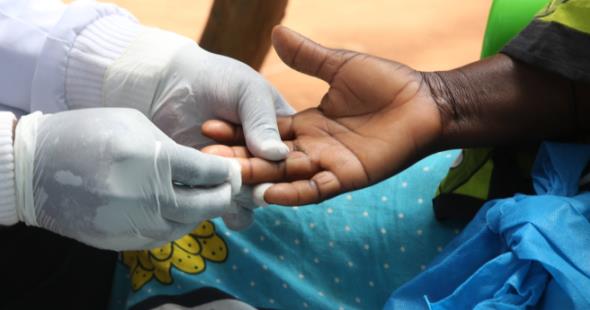Goals: UHC & health emergencies

Strong, universally accessible health systems are essential for both day-to-day patient care and to mitigate health emergencies – UHC and global health security have been described by Dr Tedros Adhanom Ghebreyesus, Director General of WHO, as “two sides of the same coin.”
In support of universal health coverage (UHC), our goal is to expand primary care testing to combat diseases that disproportionately affect vulnerable populations. We are working with partners to:
- Provide R&D support for products that can address WHO Essential Diagnostic List priorities, including commoditized tests, self-tests, multi-pathogen platforms and multiplex tests
- Improve the usability of existing tests, such as targeted redesign to make them more suitable for community-based use
- Develop complementary digital tools so that diagnostic data can be captured and fed into health information systems, to inform policy and planning
- Pursue active market sustainability initiatives to increase the availability and affordability of new tests
- Create a digital marketplace to provide transparent, verified information on diagnostic tools
- Enable targeted investments and technology transfers, to build local manufacturing capacity in low- and middle-income countries (LMICs)
- Demonstrate the impact of innovative delivery models, notably through communities and in non-formal health settings
- Support countries to introduce policy changes that can improve access to testing, such as embedding self-testing into national health strategies and insurance schemes, and to expand procurement channels to non-donor channels (such as the private sector)
To mitigate health emergencies, our goal is to strengthen diagnostic surveillance and response systems to contain outbreaks and improve pandemic preparedness, aligned with a One Health approach. We are working with partners to:
- Address not only recognized epidemic-prone pathogens such as SARS-CoV-2 and Ebola virus, but also the “silent pandemic” of antimicrobial resistance (AMR) by improving access to AMR testing and surveillance to safeguard drugs and reduce mortality
- Intensify efforts to realize mass testing for test-trace-isolate implementation and sequencing-based surveillance – so that SARS-Cov-2 viral evolution does not jeopardize progress against the COVID-19 pandemic
- Leverage ACT-Accelerator partnerships to protect the gains being made during the pandemic and build a more permanent structure that can deliver sustained supply and predictable demand of WHO Blueprint pathogen tests, as well as providing permanent early-warning and response systems
- Support development of broad menu, flexible tests – which can build from existing networks such as the WHO GISRS and PIP, or the International Atomic Energy Agency’s ZODIAC
- Encourage and provide mechanisms for transparent evidence and sample sharing, and data integration in support of One Health initiatives
- Build capacity in countries for both centralized and decentralized real-time surveillance and mechanisms for scale-up of outbreak pathogen testing
Programmatic goals
|
UNIVERSAL HEALTH COVERAGE: Expand primary care testing to combat diseases that disproportionately affect vulnerable populations |
HEALTH EMERGENCIES: Strengthen diagnostic surveillance and response systems to contain outbreaks and improve pandemic preparedness, aligned with a one health approach |
|
| DISEASES & POPULATIONS |
|
|
| DIAGNOSTIC ECOSYSTEM |
|
|
Quick links
x
x

